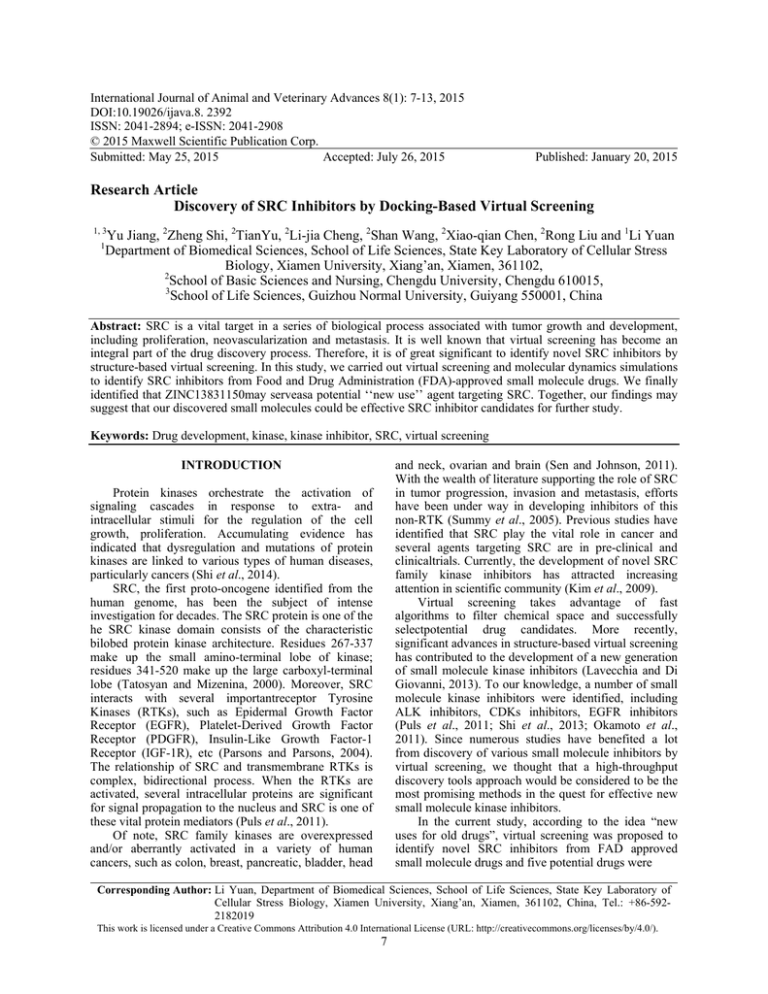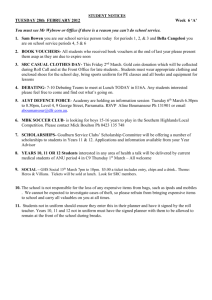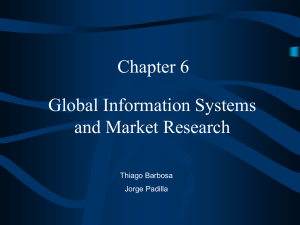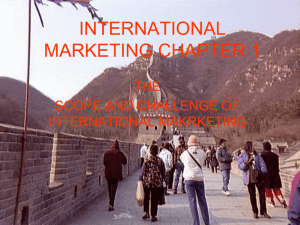International Journal of Animal and Veterinary Advances 8(1): 7-13, 2015
advertisement

International Journal of Animal and Veterinary Advances 8(1): 7-13, 2015 DOI:10.19026/ijava.8. 2392 ISSN: 2041-2894; e-ISSN: 2041-2908 © 2015 Maxwell Scientific Publication Corp. Submitted: May 25, 2015 Accepted: July 26, 2015 Published: January 20, 2015 Research Article Discovery of SRC Inhibitors by Docking-Based Virtual Screening 1, 3 1 Yu Jiang, 2Zheng Shi, 2TianYu, 2Li-jia Cheng, 2Shan Wang, 2Xiao-qian Chen, 2Rong Liu and 1Li Yuan Department of Biomedical Sciences, School of Life Sciences, State Key Laboratory of Cellular Stress Biology, Xiamen University, Xiang’an, Xiamen, 361102, 2 School of Basic Sciences and Nursing, Chengdu University, Chengdu 610015, 3 School of Life Sciences, Guizhou Normal University, Guiyang 550001, China Abstract: SRC is a vital target in a series of biological process associated with tumor growth and development, including proliferation, neovascularization and metastasis. It is well known that virtual screening has become an integral part of the drug discovery process. Therefore, it is of great significant to identify novel SRC inhibitors by structure-based virtual screening. In this study, we carried out virtual screening and molecular dynamics simulations to identify SRC inhibitors from Food and Drug Administration (FDA)-approved small molecule drugs. We finally identified that ZINC13831150may serveasa potential ‘‘new use’’ agent targeting SRC. Together, our findings may suggest that our discovered small molecules could be effective SRC inhibitor candidates for further study. Keywords: Drug development, kinase, kinase inhibitor, SRC, virtual screening and neck, ovarian and brain (Sen and Johnson, 2011). With the wealth of literature supporting the role of SRC in tumor progression, invasion and metastasis, efforts have been under way in developing inhibitors of this non-RTK (Summy et al., 2005). Previous studies have identified that SRC play the vital role in cancer and several agents targeting SRC are in pre-clinical and clinicaltrials. Currently, the development of novel SRC family kinase inhibitors has attracted increasing attention in scientific community (Kim et al., 2009). Virtual screening takes advantage of fast algorithms to filter chemical space and successfully selectpotential drug candidates. More recently, significant advances in structure-based virtual screening has contributed to the development of a new generation of small molecule kinase inhibitors (Lavecchia and Di Giovanni, 2013). To our knowledge, a number of small molecule kinase inhibitors were identified, including ALK inhibitors, CDKs inhibitors, EGFR inhibitors (Puls et al., 2011; Shi et al., 2013; Okamoto et al., 2011). Since numerous studies have benefited a lot from discovery of various small molecule inhibitors by virtual screening, we thought that a high-throughput discovery tools approach would be considered to be the most promising methods in the quest for effective new small molecule kinase inhibitors. In the current study, according to the idea “new uses for old drugs”, virtual screening was proposed to identify novel SRC inhibitors from FAD approved small molecule drugs and five potential drugs were INTRODUCTION Protein kinases orchestrate the activation of signaling cascades in response to extra- and intracellular stimuli for the regulation of the cell growth, proliferation. Accumulating evidence has indicated that dysregulation and mutations of protein kinases are linked to various types of human diseases, particularly cancers (Shi et al., 2014). SRC, the first proto-oncogene identified from the human genome, has been the subject of intense investigation for decades. The SRC protein is one of the he SRC kinase domain consists of the characteristic bilobed protein kinase architecture. Residues 267-337 make up the small amino-terminal lobe of kinase; residues 341-520 make up the large carboxyl-terminal lobe (Tatosyan and Mizenina, 2000). Moreover, SRC interacts with several importantreceptor Tyrosine Kinases (RTKs), such as Epidermal Growth Factor Receptor (EGFR), Platelet-Derived Growth Factor Receptor (PDGFR), Insulin-Like Growth Factor-1 Receptor (IGF-1R), etc (Parsons and Parsons, 2004). The relationship of SRC and transmembrane RTKs is complex, bidirectional process. When the RTKs are activated, several intracellular proteins are significant for signal propagation to the nucleus and SRC is one of these vital protein mediators (Puls et al., 2011). Of note, SRC family kinases are overexpressed and/or aberrantly activated in a variety of human cancers, such as colon, breast, pancreatic, bladder, head Corresponding Author: Li Yuan, Department of Biomedical Sciences, School of Life Sciences, State Key Laboratory of Cellular Stress Biology, Xiamen University, Xiang’an, Xiamen, 361102, China, Tel.: +86-5922182019 This work is licensed under a Creative Commons Attribution 4.0 International License (URL: http://creativecommons.org/licenses/by/4.0/). 7 Int. J. Anim. Veter. Adv., 8(1): 7-13, 2015 ligand topology was generated using PRODRG2 server (Van Der Spoel et al., 2005; Schuttelkopf and van Aalten, 2004). With a 1.0 solute-wall minimum distance, we defined the unit cell as cubic box and filled it with Single Point Charge (SPC) water molecules. The systems were solvated by TI3P water molecules. Na+ and Cl- were subsequently added to simulate a physiological NaCl concentration of 0.15 M in order to make the system neutral. Following a steepest descent energy minimization with Particle Mesh Ewald (PME) at every step, Src-ligand complexes were equilibrated 100ps under constant volume (NVT) and constant pressure (NPT) condition, respectively, during which position restraints were simultaneously applied to Src and ligands. In NVT equilibration, the temperature was maintained at 300K by the Berendsen weak coupling method.In addition, under NPT equilibration, the temperature was controlled by the Berendsen weak coupling method and the pressure was maintained at 1 bar by Parrinello-Rahmanbarostat method (Wang et al., 2015). Upon completion of the two equilibration phases, production MD simulations were conducted for 1ns after taking away the position restraints. In this data collection phase, the temperature and pressure were maintained by the same methods as in NPT phase and the coordinates were saved every 0.2 ps. For all simulations, LINCS algorithm was applied to constrain all bonds (Bussi et al., 2007). The resulting trajectory files were viewed and analyzed using UCSF Chimera (Pettersen et al., 2004). chosen according to their amber scores. Additionally, molecular dynamics simulations were further used to investigate the affinities and stabilities of SRC with above-described small molecule drugs. Moreover, we further predicted several micro RNAs which could potential target and regulated the expression of SRC. In summary, our results may provide new insights for identification of new kinase inhibitors which would be an effective promising approach for cancer treatment. MATERIALS AND METHODS Virtual screening: The initial three-dimensional geometric co-ordinates of the X-ray crystal structure of SRC (PDB: 1YI6) was downloaded from the Protein Database Bank (PBD) (http://www.rcsb.org/pdb/home/ home. do). Subsequently, we built screening library from Food and Drug Administration (FDA)-approved small molecule compounds which totally 1408 small molecule drugs were selected to predict novel kinase inhibitors targeting SRC kinase. The molecular docking calculations were performed using UCSF DOCK 6.4 program with flexible ligand docking method in which the ligand would be allowed to be structurally rearranged in response to the receptor (Shi et al., 2013). We carried out flexible-ligand docking to a rigid receptor with gridbased scoring, in which the ligands (small molecule drugs) were allowed to be structurally rearranged in response to these kinases. In order to make the results more accurate, the data were scored twice (Shi et al., 2013). In docking processes, maximum number of orientations was set to 500 (Lang et al., 2009). Subsequently, amber scoring function in DOCK 6.4 was used to re-rank the top 100 small molecule compounds from the previous grid-based scoring. During the amber score calculation, the PDB2PQR server was utilized to assign the protonation state of PDB files with AMBER forcefield and PROPKA was applied to maintain protonation state at PH = 7.0 (Dolinsky et al., 2004). RESULTS AND DISCUSSION FDA-approved drugs bind with SRC protein by virtual screening: In order to study the ligand-protein interactions, we finally collected 10 ligands and docked them to Srckinase domain. The results were shown in Table 1. The amber scores of these 10 ligands in complex with SRC ranged from -28.764275 to47.19648. Subsequently, top5 docking results were chosen for the further molecular dynamics simulations analysis. Molecular dynamics simulations: The GROMACS package (version 4.5) was employed to perform molecular dynamics simulations analysis of the dynamic behavior of SRCcomplexedwithtop5 potential drugs and the protein topology was constructed by pdb2gmx with GROMOS96 43a1 force field while the Molecular dynamics simulations: To verify whether the binding between top5 potential small molecule drugsandSrc could maintain stable, we performed a molecular dynamics simulations via the protocol described above, which indicated that the time-evolving Table 1: Molecular docking results of SRC in complex with FDA-approved small molecule drugs ZINC number Amberscore ZINC12402582 -47.19648 ZINC19364228 -37.282024 ZINC13831150 -33.161068 ZINC19796082 -32.62228 ZINC19418959 -30.689945 ZINC03943279 -30.236164 ZINC00113378 -29.643848 ZINC19796018 -29.616451 ZINC52955754 -29.035458 ZINC14294279 -28.764275 8 Name Memantine Buclizine Lumefantrine minaprine hydrochloride Trifluoperazine Dihydrochloride Pradaxa Chloramphenicol Prochlorperazine Ergotamine Tartrate Olmesartan Int. J. Anim. Veter. Adv., 8(1): 7-13, 2015 Fig. 1: Root mean square deviations (RMSD) of Src-drug complexes backbone atoms during the molecular dynamics simulations Fig. 2: Root mean square fluctuations (RMSF) of the backbone atoms versus the residue number of the Src-drug complexes during molecular dynamics simulations structure ensemble, representing the solution conformation of the proteins, exhibited different dynamic processes according to different ligands. First, we used the Root-Mean-Square Deviation (RMSD) of the atomic positions to examine conformational variations of Srccomplexes for 5ns. The overall conformational evolution of the Src-inhibitor complexes during the room-temperature simulation was analyzed. Src-ZINC12402582, Src-ZINC13831150, Src-ZINC19796082, Src-ZINC19418959showeda similarlyfluctuation during the whole simulation (shown in Fig. 1). While the SRC-ZINC19364228 system exhibited maximum deviation. Generally speaking, all the complexes could reach equilibrium at ~3ns. A detailed analysis of the Root-Mean-Square Fluctuation (RMSF) versus the residue number in the complex is illustrated in Fig. 2. As seen from Fig. 2, the region around Glu280, Ala293, Lys321, Glu331, Lys356-Val394, Ser443 and Leu494 showed minimum RMS fluctuation value of about 0.05 Å. In addition to the N- and C-terminal residues, the regions aroundGly274, Ser303, Glu331, Glu353, Gly421 and Asn468 showed the biggest dynamic fluctuations. In 9 Int. J. Anim. Veter. Adv., 8(1): 7-13, 2015 Fig. 3: Secondary structural variations of Src-drug complexes during molecular dynamics simulations Finally, we calculated the binding energy and interaction energy. Figure 4 showed that the energy of the five systems could achieve equilibrium at last. Considering the average energy in Table 2, SRCZINC13831150 system exhibited the lowest interaction energy of -312.498, indicating ZINC13831150 could bind with SRC in a more stable state than other four compounds. According to the above results and analysis, we propose ZINC13831150 as the most promising lead compound targeting SRC (Fig. 5). It is known to all that protein kinase inhibitors have made a substantial beneficial impact on the therapeutic care of cancer patients. Additionally, among varieties of computational drug repositioning methods, molecular docking screening has been widely used to date. As the addition, the Src-ZINC19418959 system had a remarkably higher peak than other systems at the Gly421 residue. Moreover, the secondary structure could also depict the stability of such a system. Figure 3 indicates that the residues around 300 of Src-ZINC19796082 system changed from A-Helix to 3-helix at ~0.6ns, then mainly stayed at A-Helix at ~1.6ns. While the other systems remain relatively stable. The residues 400-420 of the five systems changed similarly which in accordance with Fig. 2. However, the binding domains which can form a tunnel-like hydrophobic cavity are relatively stable during MD simulations. No water molecules are observed within the hydrophobic cavity throughout the whole simulations. 10 Int. J. Anim. Veter. Adv., 8(1): 7-13, 2015 Table 2: Molecular Dynamics Simulations results of SRCin complex with FDA-approved smallmolecule drugs Ligand Abbr. Ecoul Evdw Potential energy Kinetic energy Total energy SRC-ZINC12402582 -158.670 -33.6056 -871041 158435 -712606 SRC-ZINC13831150 -135.788 -176.710 -869810 158369 -711441 SRC-ZINC19796082 -23.9714 -145.813 -870890 158435 -712454 SRC-ZINC19364228 -37.4171 -132.516 -870126 158422 -711704 SRC-ZINC19418959 -59.3897 -125.216 -870103 158392 -711711 Interaction energy -192.276 -312.498 -169.784 -169.933 -184.606 Fig. 4: Plots for the composition of interaction energy of Src with different small molecules during the molecular modeling Fig. 5: Potential small molecule drug targeting Src 11 Int. J. Anim. Veter. Adv., 8(1): 7-13, 2015 Dolinsky, T.J., J.E. Nielsen, J.A. McCammon and N.A. Baker, 2004. PDB2PQR: An automated pipeline for the setup of Poisson-Boltzmann electrostatics calculations. Nucleic Acids Res., 32: W665-667. Finn, R.S., 2008. Targeting Src in breast cancer. Annals of oncology: official journal of the European Society for Medical Oncology/ESMO, 19: 1379-1386. Kim, L.C., L. Song and E.B. Haura, 2009. Src kinases as therapeutic targets for cancer. Nature Rev. Clin. Oncol., 6: 587-595. Kopetz, S., A.N. Shah and G.E. Gallick, 2007. Src continues aging: Current and future clinical directions. Clin. Cancer Res. Offic. J. Amer. Associat. Cancer Res., 13: 7232-7236. Lavecchia, A. and C. Di Giovanni, 2013. Virtual screening strategies in drug discovery: A critical review. Current Med. Chem., 20: 2839-2860. Lang, P.T., S.R. Brozell, S. Mukherjee, E.F. Pettersen, E.C. Meng, V. Thomas, R.C. Rizzo, D.A. Case, T.L. James and I.D. Kuntz, 2009. DOCK 6: Combining techniques to model RNA-small molecule complexes. RNA, 15: 1219-1230. Okamoto, M., H. Kojima, N. Saito, T. Okabe, Y. Masuda, T. Furuya and T. Nagano, 2011. Virtual screening and further development of novel ALK inhibitors. Bioorganic Med. Chem., 19: 3086-3095. Parsons, S.J. and J.T. Parsons, 2004. Src family kinases, key regulators of signal transduction. Oncogene, 23: 7906-7909. Pettersen, E.F., T.D. Goddard, C.C. Huang, G.S. Couch, D.M. Greenblatt, E.C. Meng and T.E. Ferrin, 2004. UCSF Chimera--a visualization system for exploratory research and analysis. J. Computational Chem., 25: 1605-1612. Puls, L.N., M. Eadens and W. Messersmith, 2011. Current status of SRC inhibitors in solid tumor malignancies. Oncologist, 16: 566-578. Rothschild, S.I., O. Gautschi, E.B. Haura and F.M. Johnson, 2010. SRC inhibitors in lung cancer: Current status and future directions. Clin. Lung Cancer, 11: 238-242. Shi, Z., N. An, B. Lu, N. Zhou, S. Yang, B. Zhang, C. Li, Z. Wang, F. Wang and C. Wu, 2014. Identification of novel kinase inhibitors by targeting a kinase‐related apoptotic protein-protein interaction network in HeLa cells. Cell Proliferation, 47: 219-230. Sen, B. and F.M. Johnson, 2011. Regulation of SRC family kinases in human cancers. J. Signal Transduct., 2011: 865819. Summy, J.M., J.G. Trevino, D.P. Lesslie, C.H. Baker, W.C. Shakespeare, Y. Wang, R. Sundaramoorthi and et al., 2005. AP23846, a novel and highly potent Src family kinase inhibitor, reduces vascular endothelial growth factor and interleukin-8 expression in human solid tumor cell lines and abrogates downstream angiogenic processes. Molec. Cancer Therapeutics, 4: 1900-1911. oldest known proto-oncogene, SRC has been extensively studied and is involved in numerous intracellular processes that are important in cancer growth, progression, motility, invasion and metastasis (Finn, 2008). A number of recent studies have shown that activation of SRC family kinases leads to tumor progression and metastasis by increasing cellular migration and invasion, promoting cellgrowth and survival and deregulating expression of proangiogenic molecules. Due to the positive correlation between the development of cancer and the upregulation of SRC activity, SRC is emerging is a promising target for anticancer therapy. Hitherto, there are several small molecule inhibitors for SRC kinase that are undergoing clinical trials, such as the ATP-binding competitive inhibitors dasatinib, bosutinib, saracatinib (Summy and Gallick, 2006; Kopetz et al., 2007; Rothschild et al., 2010). Moreover, it is reported that novel SRCkinase inhibitor, AP23846 was described (Summy et al., 2005). It showed excellent potency for inhibition of SRC kinase and selectivity relative to several other oncogenic protein kinases. In the current study, according to the idea “new uses for old drugs”, we virtually screened 10 promising potential inhibitors based upon molecular docking to predict valuable drugs that could potentially act on SRC. Subsequently, we tried to look into their binding modes through molecular dynamics simulations. The RMSD of top5 complexes could reach equilibrium, indicating the complexes were relatively stable. The RMSF results demonstrated that regions which participated in the interaction had a small fluctuation. The secondary structure of SRC in 5 complexes exhibited the variations of protein upon binding potential inhibitors. Finally, the energy calculation of interaction energy showed that ZINC13831150 may serve as a most promising lead compound. In summary, these findings may not only serve as a paradigm for the repositioning of existing approved drugs, but also instill new vitality to SRC-targeted cancer therapeutics. ACKNOWLEDGMENT We are grateful to our colleagues for their critical reviews and excellent suggestions on this manuscript. This study was supported by This study was supported in part by the National Natural Science Foundation of China (No. 51402027 and No. 51203157) and grants (2007J0113, 2011J01248) of Fujian Provincial Department of Science and Technology and National Science Foundation of China (No. 51402027). REFERENCES Bussi, G., D. Donadio and M. Parrinello, 2007. Canonical sampling through velocity rescaling. J. Chem. Phys., 126: 014101. 12 Int. J. Anim. Veter. Adv., 8(1): 7-13, 2015 Shi, Z., Z.J. Wang, H.L. Xu, Y. Tian, X. Li, J. K. Bao, S.R. Sun and B.S. Yue, 2013. Modeling, docking and dynamics simulations of a non-specific lipid transfer protein from Peganum harmala L. Computational Biol. Chem., 47: 56-65. Summy, J.M. and G.E. Gallick, 2006. Treatment for advanced tumors: SRC reclaims center stage. Clin. Cancer Res. Official J. Am. Associat. Cancer Res., 12: 1398-1401. Schuttelkopf, A.W. and D.M. van Aalten, 2004. PRODRG: A tool for high-throughput crystallography of protein-ligand complexes. Acta crystallograph. Section D, Biol. crystallography, 60: 1355-1363. Shi, Z., N. An, S. Zhao, X. Li, J.K. Bao and B.S. Yue, 2013. In silico analysis of molecular mechanisms of legume lectin-induced apoptosis in cancer cells. Cell Proliferation, 46: 86-96. Tatosyan, A.G. and O.A. Mizenina, 2000. Kinases of the Src family: Structure and functions. Biochem. Biokhimiia, 65: 49-58. Van Der Spoel, D., E. Lindahl, B. Hess, G. Groenhof, A.E. Mark and H.J. Berendsen, 2005. GROMACS: Fast, flexible and free. J. Computational Chem., 26: 1701-1718. Wang, Z.J., Z.N. Wan, X.D. Chen, C.F. Wu, G.L. Gao, R. Liu, Z. Shi and J.K. Bao, 2015. In silico identification of novel kinase inhibitors by targeting B-Raf (v660e) from natural products database. J. Molecular Model., 21: 2647. 13




